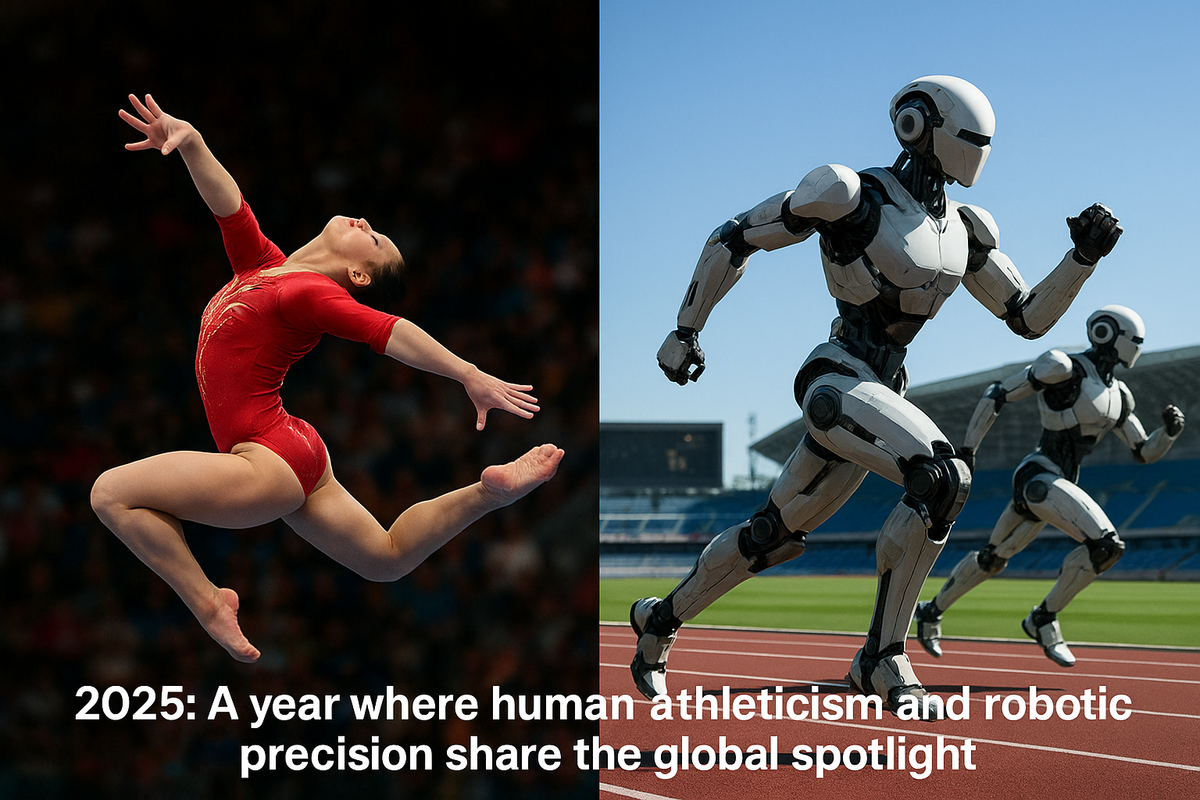World Games in Chengdu & Robot Olympics in Beijing: 2025’s Sporting Spectacles
In 2025, the world watches two extraordinary spectacles: Chengdu’s World Games showcasing human brilliance, and Beijing’s Robot Olympics pushing technological limits. Together, they redefine what competition and excellence mean in our era.

"In 2025, stadiums roar not just with the cheers of human triumph, but also with the whir of artificial muscles and silicon minds testing the limits of sport itself."
This year, the global sports stage has been nothing short of extraordinary. On one hand, the World Games in Chengdu, China, is bringing together thousands of elite athletes across diverse disciplines traditional yet cutting-edge, ranging from gymnastics and martial arts to climbing and ultimate frisbee. On the other, a futuristic spectacle unfolds in Beijing: the Robot Olympics, where humanoid machines race, wrestle, and compete in tasks once thought exclusive to humanity.
Together, these two spectacles form a story of contrasts flesh vs. metal, tradition vs. technology, and the timeless human spirit versus the limitless frontier of artificial intelligence.
The World Games in Chengdu: A Celebration of Human Skill
A Global Gathering of Talent
The World Games 2025 is a showcase of athletic brilliance outside the Olympic spotlight. Athletes from over 100 countries have arrived in Chengdu, transforming the city into a carnival of sport, culture, and celebration.
Unlike the Olympics, which focus on mainstream sports, the World Games feature disciplines like:
- Wushu and Kung Fu, paying homage to China’s martial heritage.
- Sport climbing, fast becoming a global favorite.
- Flying disc sports, where agility meets creativity.
Parkour and freestyle gymnastics, blending artistry and athleticism.

Chengdu: More Than Just a Host
Chengdu, known for its pandas, hotpot, and rich cultural history, has become a buzzing hub. Streets are filled with fans waving colorful flags, food stalls line the boulevards, and giant screens broadcast live competitions.
Beyond sport, Chengdu is leveraging the event to promote its green energy initiatives, smart city innovations, and cultural tourism—turning athletic celebration into economic and cultural opportunity.
The Rise of the Robot Olympics in Beijing
When Machines Compete
If Chengdu is about human talent, Beijing is about technological spectacle. The Robot Olympics 2025 feature humanoid robots built by teams of engineers, universities, and corporations, designed to perform tasks requiring balance, strength, and strategy.
Key events include:
- 100-meter robot sprint, where mechanical legs pump faster than ever before.
- Sumo-style robot wrestling, testing balance, force, and programming strategy.
- Soccer matches with humanoid players, each bot learning tactics in real-time.
- Cognitive challenges, where robots must solve puzzles or navigate obstacle courses.
Unlike humans, these robots don’t tire or sweat, but they do break down, glitch, and sometimes hilariously topple mid-race a reminder that even machines aren’t perfect.

Beyond Entertainment: A Test of Innovation
The Robot Olympics isn’t just spectacle it’s a proving ground for AI, robotics, and biomechanics research. Governments and corporations see it as an arena to push boundaries in:
- Exoskeleton technology that could help the disabled walk.
- AI-driven coordination applicable to disaster response.
- Autonomous decision-making in dynamic environments.
In essence, what’s being tested on the track today may find its way into hospitals, factories, and homes tomorrow.
Human Spirit vs Artificial Precision
The contrast between the two events couldn’t be sharper.
- In Chengdu, a gymnast’s shaky landing reminds us of the fragility and beauty of human effort.
- In Beijing, a robot’s flawless routine shows us the precision of machine execution.
But while robots may outperform in speed or strength, they cannot replicate the emotional stakes of a human athlete pushing against pain, fear, and exhaustion. The crowd’s tears during a victorious comeback or the heartbreak of a near-miss cannot be coded into silicon.

Cultural and Political Symbolism
China’s Dual Showcase
Hosting both the World Games and Robot Olympics, China sends a clear message: it is not only a guardian of ancient traditions and human athleticism but also a pioneer in futuristic technologies.
- The World Games show China’s ability to organize inclusive, cultural, people-driven spectacles.
- The Robot Olympics display China’s ambition to lead the world in AI, robotics, and innovation.
Global Reactions
The world watches with mixed awe and unease:
- Sports enthusiasts debate whether robots have a place in the realm of competition.
- Technologists marvel at breakthroughs.
- Philosophers and ethicists raise questions: Can sport exist without the human spirit?
The Economic Angle
- Tourism in Chengdu is booming, with hotels and restaurants overflowing.
- Tech investment in Beijing surges, as corporations showcase prototypes that attract global attention.
- Broadcasting rights and streaming audiences for both events are breaking records, showing a hunger for both timeless athletic drama and futuristic experimentation.
Key Highlights of Both Spectacles
From Chengdu’s World Games
- A 15-year-old gymnast stuns the crowd with a near-perfect vault.
- A dramatic wushu final electrifies audiences with martial artistry.
- The flying disc finals showcase athletic creativity under the night sky.
From Beijing’s Robot Olympics
- A humanoid sprinter clocks a shocking 7.8 seconds in the 100m dash.
- Two robots lock in a wrestling match that looks eerily human.
- A soccer-playing robot scores with a bicycle kick, earning cheers.
The Future of Sport
The year 2025 may be remembered as a turning point. Just as the Olympics once symbolized international unity, the dual spectacles of Chengdu and Beijing may mark a new era where sport itself is redefined.
- Will humans and robots eventually compete side by side?
- Could AI-driven athletes push humans to train smarter and harder?
- Or will there always remain a sacred boundary sport as a uniquely human pursuit of spirit, imperfection, and triumph?
Conclusion: A Tale of Two Stages
As the lights dim in Chengdu’s stadiums and Beijing’s labs pack up their robotic athletes, one thing is clear: 2025 belongs to both muscle and machine.
The World Games remind us of the enduring beauty of human effort the sweat, the struggle, the stories of perseverance. The Robot Olympics show us the thrilling, sometimes unsettling possibilities of a future where machines may share the stage.
Together, they form a striking portrait of our times: a world balancing heritage and innovation, tradition and technology, humanity and its creations.
And as audiences cheer in stadiums or marvel at humanoid athletes online, one truth resonates louder than ever: whether it’s human or machine, the pursuit of excellence will always captivate us.




